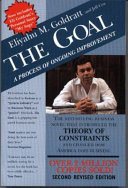

The central premise of 'The Goal' is the Theory of Constraints (TOC), which posits that any complex system, such as a manufacturing process, is limited in achieving its goals by a very small number of constraints. In a factory setting, these constraints can be bottlenecks in production that limit throughput. The book illustrates how identifying and managing these constraints can lead to significant improvements in efficiency and overall performance. The protagonist, Alex Rogo, learns to pinpoint the bottleneck in his production line and focuses efforts on optimizing that specific area. By doing so, he is able to enhance the overall productivity of the factory, demonstrating that improving the weakest link in the chain can yield substantial benefits for the entire system.
Continue readingA major theme in the book is the importance of aligning organizational goals with the overarching objective of making money. Alex Rogo's journey reveals how different departments within an organization often have conflicting goals that can hinder overall performance. The book emphasizes that every decision made should be evaluated based on its impact on the organization's primary goal—profitability. This alignment helps ensure that all employees understand their roles in contributing to the larger objectives of the company, fostering a culture of collaboration and shared purpose.
Continue readingContinuous improvement is a key concept throughout 'The Goal.' The narrative illustrates that organizations must not only identify constraints but also commit to ongoing assessment and enhancement of processes. Alex and his team adopt a mindset of constant evaluation and refinement, recognizing that what may be a constraint today could change over time. By fostering a culture of continuous improvement, organizations can adapt to changing market conditions and customer needs, ultimately leading to sustained success and competitiveness.
Continue readingMeasurement is another critical aspect discussed in 'The Goal.' The book highlights the necessity of using appropriate metrics to evaluate performance. Alex learns that traditional measures such as efficiency and utilization can be misleading and may not accurately reflect the health of the organization. Instead, he adopts metrics that focus on throughput, inventory, and operational expenses. By measuring the right variables, organizations can gain a clearer understanding of their performance and make informed decisions that drive improvement.
Continue readingThe narrative emphasizes that successful process improvement is not solely about systems and methodologies; it is also about people. Alex's journey illustrates the importance of engaging employees, fostering teamwork, and encouraging creative problem-solving. The book suggests that when individuals are empowered and involved in the process of change, they are more likely to contribute valuable insights and drive initiatives forward. This human aspect of improvement is crucial for achieving lasting results.
Continue readingIn 'The Goal,' the balance between short-term and long-term objectives is a recurring theme. Alex faces pressure to deliver immediate results while also needing to think strategically about the future of the company. The book underscores the importance of not sacrificing long-term viability for short-term gains. Organizations must find ways to achieve immediate improvements while also investing in sustainable practices that ensure future success. This dual focus helps create a resilient organization capable of navigating challenges over time.
Continue readingThe book advocates for cross-functional collaboration as a means to enhance performance. Alex learns that silos within the organization can hinder progress and that effective communication and cooperation across departments are essential for addressing constraints and achieving goals. By breaking down barriers and fostering a collaborative environment, organizations can leverage diverse perspectives and expertise, leading to more innovative solutions and improved outcomes.
Continue reading